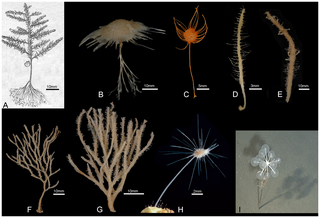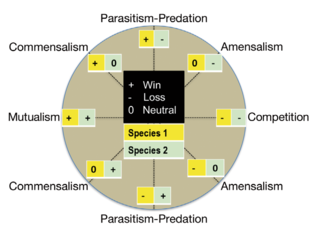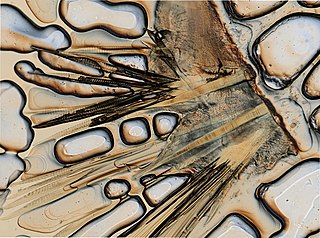
Any worm that lives in a marine environment is considered a marine worm. Marine worms are found in several different phyla, including the Platyhelminthes, Nematoda, Annelida, Chaetognatha, Hemichordata, and Phoronida. For a list of marine animals that have been called "sea worms", see sea worm.

Chondrocladia is a genus of carnivorous demosponges of the family Cladorhizidae. Neocladia was long considered a junior synonym, but has recently become accepted as a distinct genus.

Polynoidae is a family of marine Polychaete worms known as "scale worms" due to the scale-like elytra on the dorsal surface. Almost 900 species are currently recognised belonging to 9 subfamilies and 167 genera. They are active hunters, but generally dwell in protected environments such as under stones. The group is widely distributed from shallow intertidal waters to hadal trenches. They are the most diverse group of polychaetes in terms of genus number and second most diverse in terms of species number which is almost 8% of all segmented worm species.

Chondrocladia lyra, also known as the lyre sponge or harp sponge, is a species of carnivorous deep-sea sponge first discovered off the Californian coast living at depths of 10,800–11,500 feet (3,300–3,500 m) by Welton L. Lee, Henry M Reiswig, William C. Austin, and Lonny Lundsten from the Monterey Bay Aquarium Research Institute (MBARI).
Adyte hyalina is a species of marine annelids in the family Polynoidae and the only accepted species in the genus Adyte. Adyte hyalina occurs in the North-east Atlantic Ocean and Mediterranean Sea, at depths down to about 150 metres.

Cladorhizidae is a family of demosponges which are carnivorous and prey on crustaceans and other small animals. They are deep sea sponges typically found on oceanic ridges and seamount systems. As of 2017, nine new species have been discovered in the Southwest Indian Ocean Ridge (SWIOR) including: Abyssocladia boletiphora, Ab. corniculiphora, Ab. hemiradiata, Asbestopluma (Asbestopluma) unguiferata, As. (A.) jamescooki, As. (A.) laminachela, As. (A.) pseudoisochela, As. (A.) ramuscula and Chondrocladia (Meliiderma) rogersi.

Microbial symbiosis in marine animals was not discovered until 1981. In the time following, symbiotic relationships between marine invertebrates and chemoautotrophic bacteria have been found in a variety of ecosystems, ranging from shallow coastal waters to deep-sea hydrothermal vents. Symbiosis is a way for marine organisms to find creative ways to survive in a very dynamic environment. They are different in relation to how dependent the organisms are on each other or how they are associated. It is also considered a selective force behind evolution in some scientific aspects. The symbiotic relationships of organisms has the ability to change behavior, morphology and metabolic pathways. With increased recognition and research, new terminology also arises, such as holobiont, which the relationship between a host and its symbionts as one grouping. Many scientists will look at the hologenome, which is the combined genetic information of the host and its symbionts. These terms are more commonly used to describe microbial symbionts.

Lepidasthenia is a genus of marine Polychaete worms belonging to the family Polynoidae. Species of Lepidasthenia are found world-wide to depths of about 1200 m but are more common in shallower water.
Austropolaria is a genus of marine annelids in the family Polynoidae. The genus includes a single species, Austropolaria magnicirrata, which is known only from the Amundsen Sea in the Southern Ocean, at depths of 1000 to 1500m.
Parahololepidella is a genus of marine annelids in the family Polynoidae. The genus contains a single species, Parahololepidella greeffi, This species is known from the east equatorial Atlantic Ocean and Cape Verde Islands at a maximum depth of 30m.
Bathyeliasona abyssicola is a deep-sea scale worm which occurs widely across the Pacific and Atlantic Oceans and over a wide depth range, from 4000m to 8000m.
Austrolaenilla is a genus of marine annelids in the family Polynoidae. The genus includes 10 species which are known from depths of about 20 m to over 5000 m and from the Atlantic Ocean, Southern Ocean and Antarctic Ocean.
Brychionoe is a genus of marine annelids in the family Polynoidae. The genus includes a single species, Brychionoe karenae, which is long-bodied and occurs in the Tasman Sea at depths of 1100–1300 m.
Hermadionella is a genus of marine polychaete worms belonging to the family Polynoidae, the scaleworms. Hermadionella contains 3 species which are known from the north-west Pacific and Arctic Oceans from the intertidal to depths of about 200 m.
Hermadionella truncata is a scale worm known from the north-west Pacific and Arctic Oceans at depths down to about 200 m.
Neopolynoe is a genus of marine polychaete worms belonging to the family Polynoidae, the scaleworms. Neopolynoe contains 4 species, all known from the Atlantic Ocean from shallow water to depths of about 2500 m.

Neopolynoe acanellae is a scale worm known from the North Atlantic Ocean at depths about 400 to 2000 m.
Neopolynoe antarctica is a scale worm known from the Magallanes Region of the South Atlantic Ocean and from the Southern Ocean south of New Zealand at depths to about 200 m.
Neopolynoe paradoxa is a scale worm known from the North Atlantic Ocean around Norway at depths of about 70 to 1000 m.

Abyssocladia is a genus of the family Cladorhizidae, a family of carnivorous sponges. It is made up of at least 39 species found in oceans all over the world.








